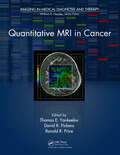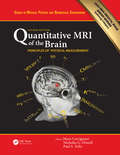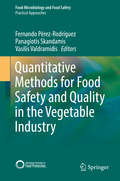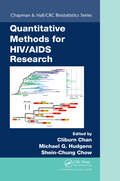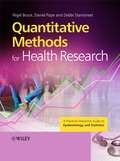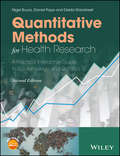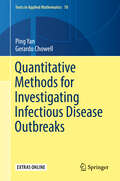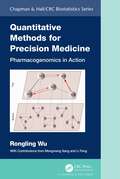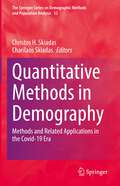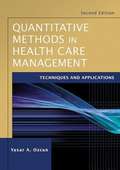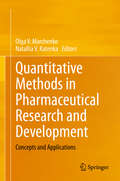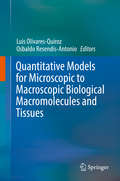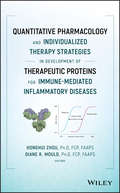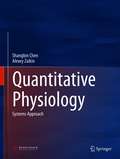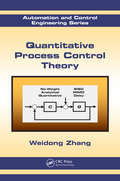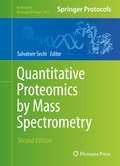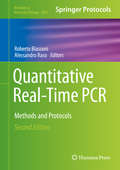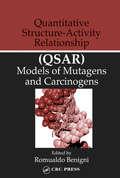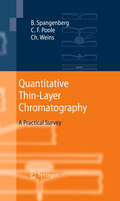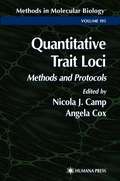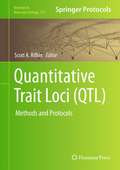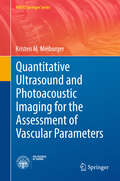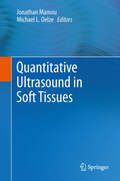- Table View
- List View
Quantitative MRI in Cancer (Imaging in Medical Diagnosis and Therapy)
by Thomas E. Yankeelov David R. Pickens Ronald R. PricePropelling quantitative MRI techniques from bench to bedside, Quantitative MRI in Cancer presents a range of quantitative MRI methods for assessing tumor biology. It includes biophysical and theoretical explanations of the most relevant MRI techniques as well as examples of these techniques in cancer applications.The introductory part of the book c
Quantitative MRI of the Brain: Principles of Physical Measurement, Second edition (Series in Medical Physics and Biomedical Engineering)
by Mara Cercignani Nicholas G. Dowell Paul S. ToftsBuilding on the success of the first edition of this book, the winner of the 2004 British Medical Association Radiology Medical Book Competition, Quantitative MRI of the Brain: Principles of Physical Measurement gives a unique view on how to use an MRI machine in a new way. Used as a scientific instrument it can make measurements of a myriad of physical and biological quantities in the human brain and body. For each small tissue voxel, non-invasive information monitors how tissue changes with disease and responds to treatment. The book opens with a detailed exposition of the principles of good practice in quantification, including fundamental concepts, quality assurance, MR data collection and analysis and improved study statistical power through minimised instrumental variation. There follow chapters on 14 specific groups of quantities: proton density, T1, T2, T2*, diffusion, advanced diffusion, magnetisation transfer, CEST, 1H and multi-nuclear spectroscopy, DCE-MRI, quantitative fMRI, arterial spin-labelling and image analysis, and finally a chapter on the future of quantification. The physical principles behind each quantity are stated, followed by its biological significance. Practical techniques for measurement are given, along with pitfalls and examples of clinical applications. This second edition of this indispensable 'how to' manual of quantitative MR shows the MRI physicist and research clinician how to implement these techniques on an MRI scanner to understand more about the biological processes in the patient and physiological changes in healthy controls. Although focussed on the brain, most techniques are applicable to characterising tissue in the whole body. This book is essential reading for anyone who wants to use the gamut of modern quantitative MRI methods to measure the effects of disease, its progression, and its response to treatment. Features: The first edition was awarded the book prize for Radiology by the British Medical Association in 2004 Written by an authority in the field: Professor Tofts has an international reputation for quantification in MRI Gives specific ‘how to’ information for implementation of MRI measurement sequence techniques
Quantitative Methods for Food Safety and Quality in the Vegetable Industry
by Fernando Pérez-Rodríguez Panagiotis Skandamis Vasilis ValdramidisThis book focuses on the food safety challenges in the vegetable industry from primary production to consumption. It describes existing and innovative quantitative methods that could be applied to the vegetable industry for food safety and quality, and suggests ways in which such methods can be applied for risk assessment. Examples of application of food safety objectives and other risk metrics for microbial risk management in the vegetable industry are presented. The work also introduces readers to new preservation and packaging methods, advanced oxidative processes (AOPs) for disinfection, product shelf-life determination methods, and rapid analytic methods for quality assessment based on chemometrics applications, thus providing a quantitative basis for the most important aspects concerning safety and quality in the vegetable sector.
Quantitative Methods for HIV/AIDS Research (Chapman & Hall/CRC Biostatistics Series)
by Shein-Chung Chow Cliburn Chan Michael G. HudgensQuantitative Methods in HIV/AIDS Research provides a comprehensive discussion of modern statistical approaches for the analysis of HIV/AIDS data. The first section focuses on statistical issues in clinical trials and epidemiology that are unique to or particularly challenging in HIV/AIDS research; the second section focuses on the analysis of laboratory data used for immune monitoring, biomarker discovery and vaccine development; the final section focuses on statistical issues in the mathematical modeling of HIV/AIDS pathogenesis, treatment and epidemiology. This book brings together a broad perspective of new quantitative methods in HIV/AIDS research, contributed by statisticians and mathematicians immersed in HIV research, many of whom are current or previous leaders of CFAR quantitative cores. It is the editors’ hope that the work will inspire more statisticians, mathematicians and computer scientists to collaborate and contribute to the interdisciplinary challenges of understanding and addressing the AIDS pandemic.
Quantitative Methods for Health Research
by Daniel Pope Nigel Bruce Debbi StanistreetQuantitative Research Methods for Health Professionals: A Practical Interactive Course is a superb introduction to epidemiology, biostatistics, and research methodology for the whole health care community.Drawing examples from a wide range of health research, this practical handbook covers important contemporary health research methods such as survival analysis, Cox regression, and meta-analysis, the understanding of which go beyond introductory concepts.The book includes self-assessment exercises throughout to help students explore and reflect on their understanding and a clear distinction is made between a) knowledge and concepts that all students should ensure they understand and b) those that can be pursued by students who wish to do so.The authors incorporate a program of practical exercises in SPSS using a prepared data set that helps to consolidate the theory and develop skills and confidence in data handling, analysis and interpretation.
Quantitative Methods for Health Research: A Practical Interactive Guide to Epidemiology and Statistics
by Bruce Daniel Pope Debbi StanistreetA practical introduction to epidemiology, biostatistics, and research methodology for the whole health care community This comprehensive text, which has been extensively revised with new material and additional topics, utilizes a practical slant to introduce health professionals and students to epidemiology, biostatistics, and research methodology. It draws examples from a wide range of topics, covering all of the main contemporary health research methods, including survival analysis, Cox regression, and systematic reviews and meta-analysis—the explanation of which go beyond introductory concepts. This second edition of Quantitative Methods for Health Research: A Practical Interactive Guide to Epidemiology and Statistics also helps develop critical skills that will prepare students to move on to more advanced and specialized methods. A clear distinction is made between knowledge and concepts that all students should ensure they understand, and those that can be pursued further by those who wish to do so. Self-assessment exercises throughout the text help students explore and reflect on their understanding. A program of practical exercises in SPSS (using a prepared data set) helps to consolidate the theory and develop skills and confidence in data handling, analysis, and interpretation. Highlights of the book include: Combining epidemiology and bio-statistics to demonstrate the relevance and strength of statistical methods Emphasis on the interpretation of statistics using examples from a variety of public health and health care situations to stress relevance and application Use of concepts related to examples of published research to show the application of methods and balance between ideals and the realities of research in practice Integration of practical data analysis exercises to develop skills and confidence Supplementation by a student companion website which provides guidance on data handling in SPSS and study data sets as referred to in the text Quantitative Methods for Health Research, Second Edition is a practical learning resource for students, practitioners and researchers in public health, health care and related disciplines, providing both a course book and a useful introductory reference.
Quantitative Methods for Investigating Infectious Disease Outbreaks (Texts in Applied Mathematics #70)
by Ping Yan Gerardo ChowellThis book provides a systematic treatment of the mathematical underpinnings of work in the theory of outbreak dynamics and their control, covering balanced perspectives between theory and practice including new material on contemporary topics in the field of infectious disease modelling. Specifically, it presents a unified mathematical framework linked to the distribution theory of non-negative random variables; the many examples used in the text, are introduced and discussed in light of theoretical perspectives. The book is organized into 9 chapters: The first motivates the presentation of the material on subsequent chapters; Chapter 2-3 provides a review of basic concepts of probability and statistical models for the distributions of continuous lifetime data and the distributions of random counts and counting processes, which are linked to phenomenological models. Chapters 4 focuses on dynamic behaviors of a disease outbreak during the initial phase while Chapters 5-6 broadly cover compartment models to investigate the consequences of epidemics as the outbreak moves beyond the initial phase. Chapter 7 provides a transition between mostly theoretical topics in earlier chapters and Chapters 8 and 9 where the focus is on the data generating processes and statistical issues of fitting models to data as well as specific mathematical epidemic modeling applications, respectively. This book is aimed at a wide audience ranging from graduate students to established scientists from quantitatively-oriented fields of epidemiology, mathematics and statistics. The numerous examples and illustrations make understanding of the mathematics of disease transmission and control accessible. Furthermore, the examples and exercises, make the book suitable for motivated students in applied mathematics, either through a lecture course, or through self-study. This text could be used in graduate schools or special summer schools covering research problems in mathematical biology.
Quantitative Methods for Precision Medicine: Pharmacogenomics in Action (Chapman & Hall/CRC Biostatistics Series)
by Rongling WuModern medicine is undergoing a paradigm shift from a "one-size-fits-all" strategy to a more precise patient-customized therapy and medication plan. While the success of precision medicine relies on the level of pharmacogenomic knowledge, dissecting the genetic mechanisms of drug response in a sufficient detail requires powerful computational tools. Quantitative Methods for Precision Medicine: Pharmacogenomics in Action presents the advanced statistical methods for mapping pharmacogenetic control by integrating pharmacokinetic and pharmacodynamic principles of drug-body interactions. Beyond traditional reductionist-based statistical genetic approaches, statistical formulization in this book synthesizes elements of multiple disciplines to infer, visualize, and track how pharmacogenes interact together as an intricate but well-coordinated system to mediate patient-specific drug response.Features: Functional and systems mapping models to characterize the genetic architecture of multiple medication processes Statistical methods for analyzing informative missing data in pharmacogenetic association studies Functional graph theory of inferring genetic interaction networks from association data Leveraging the concept of epistasis to capture its bidirectional, signed and weighted properties Modeling gene-induced cell-cell crosstalk and its impact on drug response A graph model of drug-drug interactions in combination therapies Critical methodological issues to improve pharmacogenomic research as the cornerstone of precision medicine This book is suitable for graduate students and researchers in the fields of biology, medicine, bioinformatics and drug design and delivery who are interested in statistical and computational modelling of biological processes and systems. It may also serve as a major reference for applied mathematicians, computer scientists, and statisticians who attempt to develop algorithmic tools for genetic mapping, systems pharmacogenomics and systems biology. It can be used as both a textbook and research reference. Professionals in pharmaceutical sectors who design drugs and clinical doctors who deliver drugs will also find it useful.
Quantitative Methods for Traditional Chinese Medicine Development (Chapman And Hall/crc Biostatistics Ser.)
by Shein-Chung ChowA Western-Based Approach to Analyzing TCMsIn recent years, many pharmaceutical companies and clinical research organizations have been focusing on the development of traditional Chinese (herbal) medicines (TCMs) as alternatives to treating critical or life-threatening diseases and as pathways to personalized medicine.Quantitative Methods for Tradit
Quantitative Methods in Demography: Methods and Related Applications in the Covid-19 Era (The Springer Series on Demographic Methods and Population Analysis #52)
by Christos H. Skiadas Charilaos SkiadasThis book provides quantitative and applied methodologies in the Covid-19 era exploring important issues in demography, population studies, and health. It provides insight into health and health measures as to the healthy life years lost and the healthy life expectancy related to Covid-19 pandemic. It also describes mortality and survival and focuses on data analysis in demography and population studies. Special methods and applications in demography and society are also described, thereby including applications in society, pension and insurance. As such, this book is a valuable guide for researchers, theoreticians and practitioners from various scientific fields.
Quantitative Methods in Health Care Management
by Yasar A. OzcanThoroughly revised and updated for Excel®, this second edition of Quantitative Methods in Health Care Management offers a comprehensive introduction to quantitative methods and techniques for the student or new administrator. Its broad range of practical methods and analysis spans operational, tactical, and strategic decisions. Users will find techniques for forecasting, decision-making, facility location, facility layout, reengineering, staffing, scheduling, productivity, resource allocation, supply chain and inventory management, quality control, project management, queuing models for capacity, and simulation. The book's step-by-step approach, use of Excel, and downloadable Excel templates make the text highly practical.Praise for the Second Edition "The second edition of Dr. Ozcan's textbook is comprehensive and well-written with useful illustrative examples that give students and health care professionals a perfect toolkit for quantitative decision making in health care on the road for the twenty-first century. The text helps to explain the complex health care management problems and offer support for decision makers in this field."-Marion Rauner, associate professor, School of Business, Economics, and Statistics, University of Vienna. "Quantitative Methods in Health Care Administration, Second Edition covers a broad set of necessary and important topics. It is a valuable text that is easy to teach and learn from."-David Belson, professor, Department of Industrial Engineering, Viterbi School of Engineering, University of Southern California.
Quantitative Methods in Pharmaceutical Research and Development: Concepts and Applications
by Olga V. Marchenko Natallia V. KatenkaThis contributed volume presents an overview of concepts, methods, and applications used in several quantitative areas of drug research, development, and marketing. Chapters bring together the theories and applications of various disciplines, allowing readers to learn more about quantitative fields, and to better recognize the differences between them. Because it provides a thorough overview, this will serve as a self-contained resource for readers interested in the pharmaceutical industry, and the quantitative methods that serve as its foundation. Specific disciplines covered include:BiostatisticsPharmacometricsGenomicsBioinformaticsPharmacoepidemiologyCommercial analyticsOperational analyticsQuantitative Methods in Pharmaceutical Research and Development is ideal for undergraduate students interested in learning about real-world applications of quantitative methods, and the potential career options open to them. It will also be of interest to experts working in these areas.
Quantitative Models for Microscopic to Macroscopic Biological Macromolecules and Tissues
by Luis Olivares-Quiroz Osbaldo Resendis-AntonioThis book presents cutting-edge research on the use of physical and mathematical formalisms to model and quantitatively analyze biological phenomena ranging from microscopic to macroscopic systems. The systems discussed in this compilation cover protein folding pathways, gene regulation in prostate cancer, quorum sensing in bacteria to mathematical and physical descriptions to analyze anomalous diffusion in patchy environments and the physical mechanisms that drive active motion in large sets of particles, both fundamental descriptions that can be applied to different phenomena in biology. All chapters are written by well-known experts on their respective research fields with a vast amount of scientific discussion and references in order the interested reader can pursue a further reading. Given these features, we consider Quantitative Models for Microscopic to Macroscopic Biological Macromolecules and Tissues as an excellent and up-to-date resource and reference for advanced undergraduate students, graduate students and junior researchers interested in the latest developments at the intersection of physics, mathematics, molecular biology, and computational sciences. Such research field, without hesitation, is one of the most interesting, challenging and active of this century and the next.
Quantitative Models in Life Science Business: From Value Creation to Business Processes (SpringerBriefs in Economics)
by Jung Kyu Canci Philipp Mekler Gang MuThis open access book explores the field of life science business from a multidisciplinary perspective. Applying statistical, mathematical, game-theoretic, and data science tools to pharmaceutical and biotechnology business endeavors, the book describes value creation, value maintenance, and value realization in the life sciences as a sequence of processes using the quantitative language of applied mathematics. Written by experts from a variety of fields, the contributions illustrate the shift from a deterministic to a stochastic view of the processes involved, offering a new perspective on life sciences economics. The book covers topics such as valuing and managing intellectual property in life science, licensing in the pharmaceutical business, outsourcing pharmaceutical R&D, and stochastic modelling of a pharmaceutical supply chain. The book will appeal to scholars of economics and the life sciences, as well as to professionals in chemical and pharmaceutical industries.
Quantitative Pharmacology and Individualized Therapy Strategies in Development of Therapeutic Proteins for Immune-Mediated Inflammatory Diseases
by Honghui Zhou Diane R. MouldThorough Overview Identifies and Addresses Critical Gaps in the Treatment of Several Chronic Diseases With increasing numbers of patients suffering from Immune-Mediated Inflammatory Diseases (IMIDs), and with the increasing reliance on biopharmaceuticals to treat them, it is imperative that researchers and medical practitioners have a thorough understanding of the absorption, distribution, metabolism and excretion (ADME) of therapeutic proteins as well as translational pharmacokinetic/pharmacodynamic (PK/PD) modeling for them. This comprehensive volume answers that need to be addressed. Featuring eighteen chapters from world-renowned experts and opinion leaders in pharmacology, translational medicine and immunology, editors Honghui Zhou and Diane Mould have curated a much-needed collection of research on the advanced applications of pharmacometrics and systems pharmacology to the development of biotherapeutics and individualized treatment strategies for the treatment of IMIDs. Authors discuss the pathophysiology of autoimmune diseases in addition to both theoretical and practical aspects of quantitative pharmacology for therapeutic proteins, current translational medicine research methodologies and novel thinking in treatment paradigm strategies for IMIDs. Other notable features include: • Contributions from well-known authors representing leading academic research centers, specialized contract research organizations and pharmaceutical industries whose pipelines include therapeutic proteins • Chapters on a wide range of topics (e.g., pathophysiology of autoimmune diseases, biomarkers in ulcerative colitis, model-based meta-analysis use in the development of therapeutic proteins) • Case studies of applying quantitative pharmacology approaches to guiding therapeutic protein drug development in IMIDs such as psoriasis, inflammatory bowel disease, multiple sclerosis and lupus Zhou and Mould’s timely contribution to the critical study of biopharmaceuticals is a valuable resource for any academic and industry researcher working in pharmacokinetics, pharmacology, biochemistry, or biotechnology as well as the many clinicians seeking the safest and most effective treatments for patients dealing with chronic immune disorders.
Quantitative Physiology: Systems Approach
by Shangbin Chen Alexey ZaikinStephen Hawking says that the 21st century will be the century of complexity and indeed now systems biology or medicine means dealing with complexity. Both the genome and physiome have emerged in studying complex physiological systems. Computational and mathematical modeling has been regarded as an efficient tool to boost the understanding about living systems in normal or pathophysiological states.Covering applied methodology, basic case studies and complex applications, this volume provides researchers with an overview of modeling and computational studies of physiology (i.e. quantitative physiology), which is becoming an increasingly important branch of systems biology.This book aims to build multi-scale models to investigate functions in living systems and explain how biomolecules, cells, organs, organ systems and organisms carry out the chemical or physical functions. Some of the models addressed are related to gene expression, calcium signalling, neural activity, blood dynamics and bone mechanics.Combining theory and practice, with extensive use of MATLAB, this book is designed to establish a paradigm for quantitative physiology by integrating biology, mathematics, physics and informatics etc. To benefit from this book, the readers are expected to have a background in general physiology and mathematics
Quantitative Process Control Theory (ISSN)
by Weidong ZhangQuantitative Process Control Theory explains how to solve industrial system problems using a novel control system design theory. This easy-to-use theory does not require designers to choose a weighting function and enables the controllers to be designed or tuned for quantitative engineering performance indices such as overshoot.In each chapter, a s
Quantitative Proteomics by Mass Spectrometry
by Salvatore SechiThis volume is a compendium of cutting-edge protocols for quantitative proteomics, and presents the most significant methods used in the field today. The focus on mass spectrometry (MS) is integral. Attention is given to state-of-the-art techniques for the characterization of the phosphoproteome and tandem MS for detection of inborn errors of metabolism. This volume is an indispensable resource in the search for novel biomarkers.
Quantitative Real-Time PCR: Methods and Protocols (Methods in Molecular Biology #2065)
by Roberto Biassoni Alessandro RasoThis book expands upon the useful first edition by exploring classic Quantitative Polymerase Chain Reaction (qPCR) techniques as well as a number of recently developed applications. With the changes in instrumentation due to technological advances and the development of new reagents to fulfill ethical and legal issues, the qPCR field is now an up-to-date technology that indeed is widely used in research and clinical diagnostics. Written for the highly successful Methods in Molecular Biology series, chapters include introductions to their respective topics, lists of the necessary reagents, step-by-step, readily reproducible laboratory protocols, and tips on troubleshooting and avoiding known pitfalls. Revised and authoritative, Quantitative Real-Time PCR: Methods and Protocols, Second Edition is an ideal guide to this expanding and vital field of study.
Quantitative Structure-Activity Relationship (QSAR) Models of Mutagens and Carcinogens
by Romualdo BenigniApplied with success in a number of areas, QSAR studies have become particularly popular in the rational design of drugs and pesticides. Much has been published on the principles of QSAR in this area, but not on their application s to toxic chemicals. This book provides the first comprehensive, interdisciplinary presentation of QSAR studies on
Quantitative Thin-Layer Chromatography
by Bernd Spangenberg Colin F. Poole Christel WeinsThin-layer chromatography (TLC) is widely used particularly for pharmaceutical and food analysis. While there are a number of books on the qualitative identification of chemical substances by TLC, the unique focus here is on quantitative analysis. The authors describe all steps of the analytical procedure, beginning with the basics and equipment for quantitative TLC followed by sample pretreatment and sample application, development and staining, scanning, and finally statistical and chemometric data evaluation and validation. An important feature is the coverage of effect-directed biological detection methods. Chapters are organized in a modular fashion facilitating the easy location of information about individual procedural steps.
Quantitative Trait Loci
by Angela Cox Nicola J. CampIn Quantitative Trait Loci: Methods and Protocols, a panel of highly experienced statistical geneticists demonstrate in a step-by-step fashion how to successfully analyze quantitative trait data using a variety of methods and software for the detection and fine mapping of quantitative trait loci (QTL). Writing for the nonmathematician, these experts guide the investigator from the design stage of a project onwards, providing detailed explanations of how best to proceed with each specific analysis, to find and use appropriate software, and to interpret results. Worked examples, citations to key papers, and variations in method ease the way to understanding and successful studies. Among the cutting-edge techniques presented are QTDT methods, variance components methods, and the Markov Chain Monte Carlo method for joint linkage and segregation analysis.
Quantitative Trait Loci (QTL)
by Scott A. RifkinOver the last two decades advances in genotyping technology, and the development of quantitative genetic analytical techniques have made it possible to dissect complex traits and link quantitative variation in traits to allelic variation on chromosomes or quantitative trait loci (QTLs). In Quantitative Trait Loci (QTLs):Methods and Protocols, expert researchers in the field detail methods and techniques that focus on specific components of the entire process of quantitative train loci experiments. These include methods and techniques for the mapping populations, identifying quantitative trait loci, extending the power of quantitative trait locus analysis, and case studies. Written in the highly successful Methods in Molecular BiologyTM series format, the chapters include the kind of detailed description and implementation advice that is crucial for getting optimal results in the laboratory. Thorough and intuitive, Quantitative Trait Loci (QTLs):Methods and Protocols aids scientists in the further study of the links between phenotypic and genotypic variation in fields from medicine to agriculture, from molecular biology to evolution to ecology.
Quantitative Ultrasound and Photoacoustic Imaging for the Assessment of Vascular Parameters
by Kristen M. MeiburgerThis book describes the development of quantitative techniques for ultrasound and photoacoustic imaging in the assessment of architectural and vascular parameters. It presents morphological vascular research based on the development of quantitative imaging techniques for the use of clinical B-mode ultrasound images, and preclinical architectural vascular investigations on quantitative imaging techniques for ultrasounds and photoacoustics. The book is divided into two main parts, the first of which focuses on the development and validation of quantitative techniques for the assessment of vascular morphological parameters that can be extracted from B-mode ultrasound longitudinal images of the common carotid artery. In turn, the second part highlights quantitative imaging techniques for assessing the architectural parameters of vasculature that can be extracted from 3D volumes, using both contrast-enhanced ultrasound (CEUS) imaging and photoacoustic imaging without the addition of any contrast agent. Sharing and summarizing the outcomes of this important research, the book will be of interest to a broad range of researchers and practitioners in the fields of medical imaging and biomedical engineering.
Quantitative Ultrasound in Soft Tissues
by Jonathan Mamou Michael L. OelzeDue to parallel advances in signal processing and computer hardware in the last 15 years, quantitative ultrasound techniques have reached maturity, allowing for the construction of quantitative maps or images of soft tissues. This book will focus on 5 modern research topics related to quantitative ultrasound of soft tissues: - Spectral-based methods for tissue characterization, tissue typing, cancer detection, etc. ; - Envelope statistics analysis as a means of quantifying and imaging tissue properties; - Ultrasound elastography for quantifying elastic properties of tissues (several clinical ultrasound scanners now display elastography images); - Scanning acoustic microscopy for forming images of mechanical properties of soft tissues with micron resolution (desktop size scanners are now available); and - Ultrasound computer tomography for breast cancer imaging (new ultrasound tomography systems have been developed and are currently under evaluation clinically).
